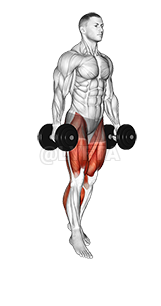
Rowing
Exercise Profile
Related Exercises:
Introduction to the Rowing
Rowing is a low-impact, full-body workout that enhances cardiovascular health, builds muscle strength, and improves flexibility. It's an ideal exercise for individuals of all fitness levels, from beginners to seasoned athletes, as it can be adapted to suit anyone's capabilities. People might choose rowing because it not only promotes physical fitness, but also aids in stress reduction and improves mental well-being.
Performing the: A Step-by-Step Tutorial Rowing
- Extend your arms straight towards the flywheel while keeping your back straight and pushing off the foot pads using your legs until they are almost fully extended.
- Once your legs are extended, lean your upper body back slightly and pull the handle towards your lower chest, keeping your elbows tucked in close to your body.
- After the handle touches your chest, reverse the motion by extending your arms back towards the flywheel, then lean your body forward, and finally bend your legs to return to the starting position.
- Repeat these steps for the desired number of repetitions or for a set duration of time.
Tips for Performing Rowing
- **Correct Grip**: Hold the handle with an overhand grip and your hands shoulder-width apart. Avoid gripping too tightly as this can lead to unnecessary strain on your hands and wrists.
- **Powerful Leg Drive**: A common mistake is to pull primarily with the arms. Remember that rowing is a full-body exercise and should be initiated with a powerful push from your legs. Your arms should follow naturally, pulling the handle towards your lower chest.
- **Controlled Movement**: Avoid rushing through the motion. It's better to perform the exercise slowly and with control, focusing on the muscle groups being worked. The return phase (when you move back to the starting position) should also be controlled, not just letting the
Rowing FAQs
Can beginners do the Rowing?
Yes, beginners can absolutely do rowing exercises. It's a great full-body workout that targets several major muscle groups, including your arms, legs, and core. However, proper form is crucial to prevent injury and get the most out of the exercise. Beginners might want to start with a lower resistance and gradually increase it as their strength and endurance improve. It could also be beneficial to have a trainer or coach guide them through the correct form and technique initially.
What are common variations of the Rowing?
- The Dumbbell Row is another variation where you use a flat bench and dumbbell, working one side of your body at a time.
- The Bent-Over Barbell Row uses a barbell and requires you to bend at the waist, engaging your core as well as your upper body.
- The Inverted Row is a bodyweight exercise where you use your own body weight for resistance, pulling yourself up to a bar.
- The Single-Arm Band Row uses a resistance band instead of weights or machines, which can be a great low-impact alternative for those with joint issues.
What are good complementing exercises for the Rowing?
- Planks enhance rowing performance by building core stability and strength, which is essential for maintaining proper rowing form and preventing injuries.
- Squats can support rowing by strengthening the quads, glutes, and hamstrings, all of which are key muscles used during the drive phase of the rowing stroke.
Related keywords for Rowing
- Rowing workout
- Leverage machine exercises
- Plyometric training
- Indoor rowing exercises
- Fitness rowing
- High-intensity rowing workout
- Full body workout with rowing
- Leverage rowing machine workout
- Plyometric rowing exercises
- Cardiovascular rowing exercise.











